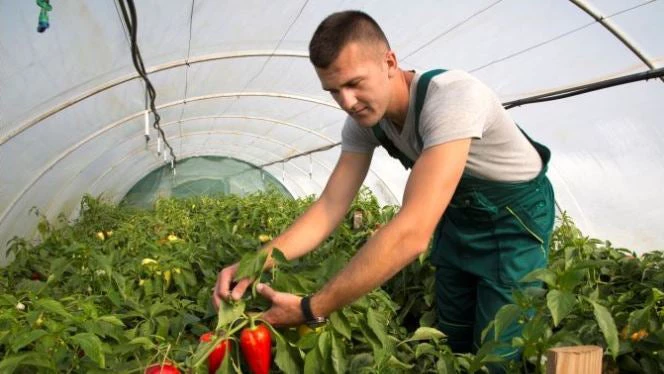
Photo: Jutta Benzenberg/World Bank
There are no simple answers.
The opportunities and challenges of EU accession
When economies integrate with foreign markets, trading opportunities, consumer choices and knowledge and technology exchanges increase. However, openness also exerts pressures on industries – including farming – to improve productivity in order to remain in business. Serbia finds itself at this very juncture. The decision to join the European Union (EU) and integrate with the EU’s highly competitive single market of 500 million consumers has raised the stakes for its economy overall, but especially agriculture.
Reasons to be optimistic — and cautious — about Serbia’s agriculture
Our recent research on Serbia’s agriculture potential gives reasons for optimism. Serbia’s agriculture benefits from a diverse resource base, fertile soils, favorable climatic conditions, experienced farmers, good infrastructure, as well as a rich farming tradition. Unsurprisingly, agriculture remains very important to Serbia’s economy, accounting for roughly 10% of GDP, 21% of all employment and 23% of exports. A real export boom has doubled agriculture export earnings over the past 10 years and shown that Serbia can compete internationally.
Yet, Serbia’s agriculture is bound by constraints that have caused regional disparities and declining incomes from dairy and livestock production. The biggest constraint is Serbia’s current farm structure, which remains dominated by small farms. Of more than 630,000 agricultural holdings, almost 80% had less than 5 hectares and only 5% of livestock holdings owned more than 10 dairy cows. These will have a harder time competing with larger and more technologically advanced foreign competitors.
Diverse sources of rural income are another complicated piece of the puzzle. Even in Vojvodina where agricultural growth has recently been strongest, earnings from farming remain at around 20% on average. In other words, rural households secure 80% of their income from other sources, mainly pensions and off-farm work. This has profound implications for expansion or technological upgrades. Why would a farmer invest, if off-farm work offers better income?
Focusing on medium-sized farms
Public policy should help farmers make the right decisions. Yet Serbia’s current agriculture policy falls short. Financial support for farmers is based on the size of land under cultivation and the number of animals in the stable. While this approach boosts incomes, it effectively “freezes” the current farm structure as it fails to incentivize smaller farms to modernize and expand.
So what should change?
First, the Government of Serbia should provide greater investment support to medium-sized farms. The aim should be to provide farms with the incentive and the means to increase farm size, modernize production and improve competitiveness. Most importantly, this policy shift needs to distinguish between agriculture holdings that are willing to invest in improved farming and those that prefer to seek opportunities outside farming. Over time, this will result in larger, healthier and more competitive farms – or groupings of farms – fully dedicated to farming, unlike today when farming is often pursued as a part-time occupation.
Second, timely provision of quality public services to farmers and food processors is key. Most important among these are veterinary and food safety inspections that can help Serbia’s producers gain access to foreign markets and earn a reputation for quality. Organic farming certification systems also need to be put in place, as the market potential for organic products is significant.
Third, as rural households seek off-farm employment, the Government policy should support the creation of new off-farm jobs. Serbia is well positioned to expand its agro-processing sector, but there are also other sectors (e.g., manufacturing, services) that could drive the creation of rural jobs. The government’s role is to support rural development through infrastructure investment and education policy, as well as support retiring farm workers.
Finally, Bank research on earlier EU accessions shows that choices made before EU accession largely determine the performance of agriculture after accession. The most successful stories have been written by those countries that focused – also with the support of EU pre-accession funds – on strengthening the competitiveness of their agriculture sectors early on and thus helped farmers and producers better seize the opportunities of EU membership. Poland could serve as a positive example, as its smaller farms have prospered and its agriculture exports boomed after accession.
Looking at the glass half-full
Much will of course also depend on farmers and their willingness to cooperate and modernize. Serbia’s smallholder farming can already showcase success: raspberry exports surpassed 300 million Euros in 2013 and are now one of the most important agriculture export items, even though average farm size remains less than 0.3 hectares. Another positive example is the highly successful cooperation of small-scale export-oriented plum producers in Central Serbia. These are inspiring stories that are testament to Serbia’s farming resilience and ability to seek new markets.
The Bank is currently supporting the Government of Serbia in formulating the right strategies through the Public Sector Rightsizing and Restructuring project. Together with our counterparts in the Government of Serbia we would like to prepare a road map that re-calibrates Serbia’s agriculture policy and optimizes the use of available funds. In addition, we want to make sure that the wider agriculture administration delivers quality services and guides Serbia’s agriculture successfully towards EU membership. We remain confident that Serbia’s farmers, businesses and public authorities will live up to the challenge.



Join the Conversation